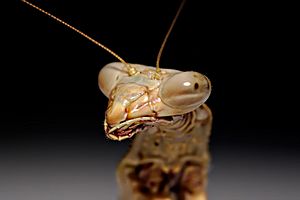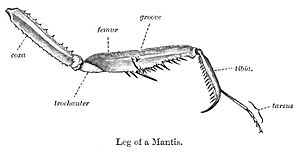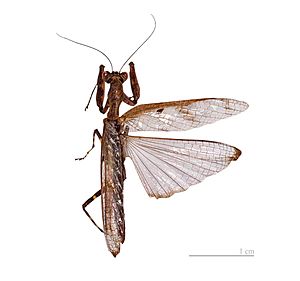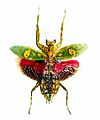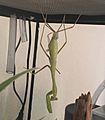Mantis facts for kids
Quick facts for kids MantodeaTemporal range: Cretaceous - Recent
|
|
|---|---|
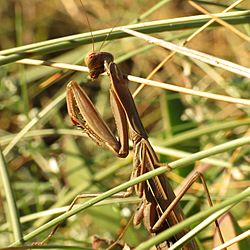 |
|
| European manits (Mantis religiosa) | |
| Scientific classification | |
| Kingdom: | |
| Phylum: | |
| Class: | |
| Subclass: | |
| Infraclass: | |
| Superorder: | |
| Order: |
Mantodea
|
A mantis is a fascinating type of insect. People often call them praying mantids because of how they hold their front legs. It looks like they are praying!
There are about 2,300 different kinds of mantises. You can find them in both warm and cool places around the world. Most of them belong to a family called Mantidae.
In Europe, the name "praying mantis" usually means just one type, Mantis religiosa. Sometimes, people confuse them with stick insects, but they are different. Mantises are closely related to cockroaches and termites.
Contents
How Mantises Hunt
Mantises are amazing hunters. They are predators, which means they hunt other animals for food. Their main diet is usually live insects, like flies and aphids. Bigger mantises can even catch small lizards, frogs, birds, snakes, and tiny rodents!
Most mantises are "ambush predators." This means they wait quietly for their prey to come close. Then, they strike out super fast! Some mantises that live on the ground or on tree bark can also chase their prey quickly.
They catch and hold their food with their strong, spiky front legs. These legs are called 'raptorial' legs. The mantis's neck is also very flexible. It can turn its head almost 300 degrees! This helps them see all around without moving their body. They rely a lot on their eyesight for hunting. So, they are mostly active during the day. But many types fly at night to avoid birds.
Mantises are also masters of camouflage. They use their colors to blend in with their surroundings. This helps them hide from their own predators and catch their victims. They can look like leaves, sticks, tree bark, grass, flowers, or even stones. Some mantises in Africa and Australia can even turn black after a forest fire. This helps them blend in with the burnt land.
Mantises can bite, but they don't have venom. They are not dangerous to humans. They don't have special chemicals to protect themselves. So, many larger animals will eat a mantis if they find one. Mantises can also be quite aggressive towards each other. They will often eat other mantises if they get the chance.
Mantis Body Parts
Anatomy of a Mantis
Mantises have large, triangle-shaped heads. They have two big compound eyes and three small simple eyes. They also have a pair of antennae. Their neck is very flexible, allowing them to turn their heads almost 180 degrees!
A mantis's body has three main parts: the head, the thorax, and the abdomen. The thorax is like their chest area. It has three segments. The first part of the thorax, called the prothorax, is very long. This part holds their head and their special front legs. It can move a lot, helping them use their front legs to catch food.
Their two front legs are spiky and strong. They use these "raptorial legs" to grab and hold their prey tightly. These legs have sharp spikes and tooth-like bumps. These help the mantis get a good grip on its food. The very end of the front leg has a delicate foot with four or five small parts. This foot helps them walk.
Mantises can have different kinds of wings. Some have long wings, some have short wings, and some have tiny wings or no wings at all. If they have wings, they have two sets. The outer wings are usually tough and narrow. They act like camouflage and protect the inner wings. The inner wings are clear and delicate.
The back part of a mantis's body is called the abdomen. It has many segments. Males usually have slimmer abdomens than females. Both males and females have a pair of small feelers called cerci at the end of their abdomen.
How Mantises See
Mantises have stereo vision, just like humans. This means they can see depth and distance. They use their sight to find their prey. Their large compound eyes are made of up to 10,000 tiny lenses. A small area at the front of their eyes helps them see things in high detail. This is important for spotting potential prey.
The outer parts of their eyes help them see movement. When something moves, the mantis quickly turns its head to focus on it. Then, it tracks the prey's movements by moving its head. Their eyes are wide apart, giving them a wide view and helping them see clearly up close. The dark spot you see on their eyes is called a pseudopupil. It moves as the mantis turns its head.
Since they rely on vision for hunting, mantises are mostly active during the day. However, many types fly at night. They might be attracted to lights. Male mantises often fly at night to find females by sensing their smells. Flying at night also helps them avoid birds that hunt during the day. Many mantises also have a special ear on their chest. This helps them hear bats and fly away to safety.
What Mantises Eat
Mantises are generalist predators, meaning they eat many different kinds of arthropods. Most mantises are ambush predators. They only eat live prey that comes within their reach. They either hide and wait, or they move slowly and sneakily to get closer to their prey.
Bigger mantises sometimes eat smaller mantises of their own kind. They can also eat small animals like lizards, frogs, and even small birds.
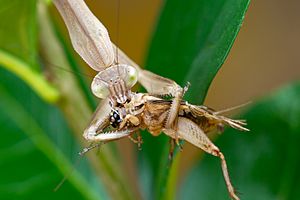
Most mantises will stalk prey if it gets close enough. They will go even further if they are very hungry. Once they are close, they strike quickly to grab the prey with their spiky front legs. Some mantises that live on the ground or on tree bark chase their prey more actively. For example, some ground mantises run over dry ground to find food, much like tiger beetles do.
Some mantises can store food in a part of their body called the foregut. This helps them save food for later digestion. This is useful for an insect that doesn't eat all the time. Chinese mantises live longer, grow faster, and have more babies if they can eat pollen.
How Mantises Stay Safe
Mantises are hunted by animals like frogs, lizards, and birds. Spiders, large hornets, and ants also prey on them. Some hunting wasps can even paralyze mantises to feed their young.
Mantises mostly protect themselves by using camouflage. Most types are colored to blend in with leaves or other backgrounds. This helps them hide from predators and also catch their prey. Mantises that live on flat surfaces like bare earth or tree bark are very flat. This helps them avoid casting shadows that might give them away.
Some mantises, called flower mantises, look just like flowers. This helps them attract prey that come to collect pollen and nectar. Some mantises in Africa and Australia can turn black after a forest fire. This helps them blend in with the burnt landscape.
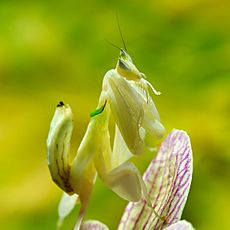
When a mantis feels threatened, many species will stand tall and spread their front legs and wings wide. This makes them look bigger and more scary. Some even have bright colors or patterns on their wings to make this display more effective. If the threat continues, a mantis might strike with its front legs or try to bite. Some mantises can also make a hissing sound by pushing air out of their bodies. Mantises don't have chemicals to protect themselves, so these displays are mostly a bluff.
When flying at night, some mantises can hear the sounds made by bats. If they hear a bat getting closer, they stop flying straight. Instead, they spiral down to the ground to safety. If caught, they might slash their attackers with their spiky legs.
Mantises, like stick insects, sometimes rock back and forth. This movement might help them look like plants swaying in the wind. It might also help them see objects better by how they move against the background. This rocking movement can help them see things clearly without flying or running.
Mantises generally avoid ants, as ants can be predators. Some young mantises even look like ants to trick predators and stay safe.
Mantis Life Cycle
The mating season for mantises in cooler places is usually in the autumn. In warmer places, they can mate any time of year.
A female mantis lays between 10 and 400 eggs, depending on the type. She lays her eggs in a foamy mass that comes from her body. This foam hardens into a protective case called an ootheca. The ootheca can be attached to a flat surface, wrapped around a plant, or even buried in the ground. Even though the eggs are protected, many are eaten by tiny parasitoid wasps. In a few types of mantises, the mother guards her eggs. For example, the Tarachodes maurus mantis hides on tree bark with her body covering her egg case. She ambushes prey and moves very little until her eggs hatch.
Mantises go through three life stages: egg, nymph, and adult. This is called hemimetabolous development. For smaller mantises, the eggs hatch in about 3–4 weeks. For larger ones, it takes 4–6 weeks. The young mantises, called nymphs, might look different from the adults. Young nymphs often look like ants.
A mantis nymph grows by molting its outer skin, called an exoskeleton. They can molt five to 10 times before they become adults. After their last molt, most mantises have wings. However, some types, especially females, may have short wings or no wings at all. The lifespan of a mantis depends on its type. Smaller ones might live 4–8 weeks, while larger ones can live 4–6 months.
Mantises as Pets

Mantises are one of the most popular insects to keep as pets. Since a mantis only lives for about a year, people who want to keep them often breed them. In 2013, at least 31 different types of mantises were kept and bred as pets in the United Kingdom, the Netherlands, and the United States.
People say that keeping a pet mantis is no stranger than having a pet rat or ferret. They also point out that a pet mantis won't bark, shed fur, or need shots or a litter box.
Images for kids
-
Leaf mimicry: Choeradodis has leaf-like fore wings and a widened green thorax.
-
Adult female Iris oratoria performs a bluffing threat display, rearing back with the forelegs and wings spread and mouth opened.
-
The jeweled flower mantis, Creobroter gemmatus: the brightly colored wings are opened suddenly in a deimatic display to startle predators.
-
Some mantis nymphs mimic ants to avoid predators.
-
Mantis religiosa mating (brown male, green female)
-
Stagmomantis carolina laying ootheca
-
Bronze ink brush rest in the shape of a mantis, Edo period, Japan, c. 1800
-
In Island, Aldous Huxley reflected on death as a pair of Gongylus gongylodes mated.
-
Grandmasters of the Shaolin Temple, Shi DeRu and Shi DeYang, demonstrating the Southern Praying Mantis style of martial art
See also
 In Spanish: Mantodeos para niños
In Spanish: Mantodeos para niños



